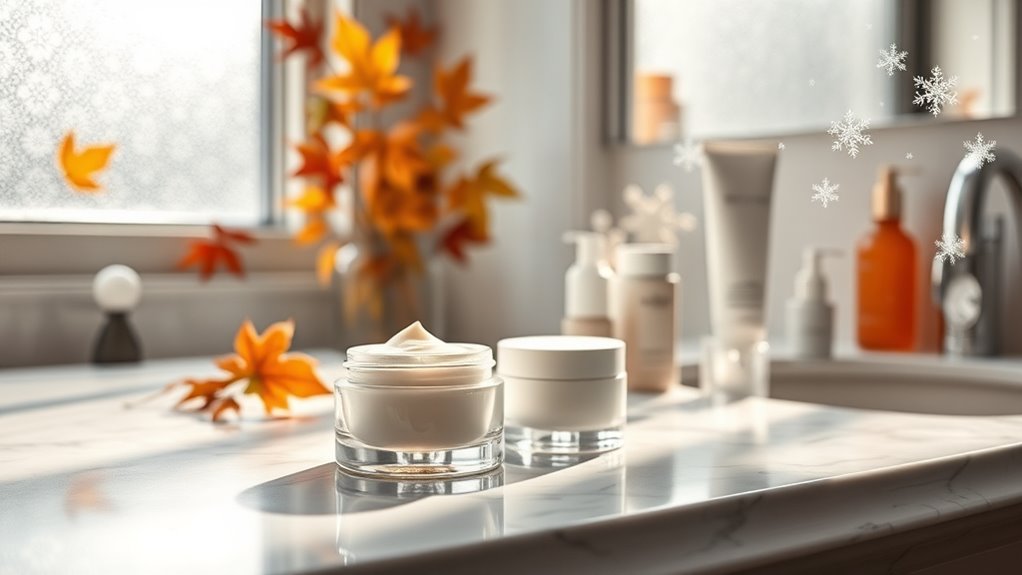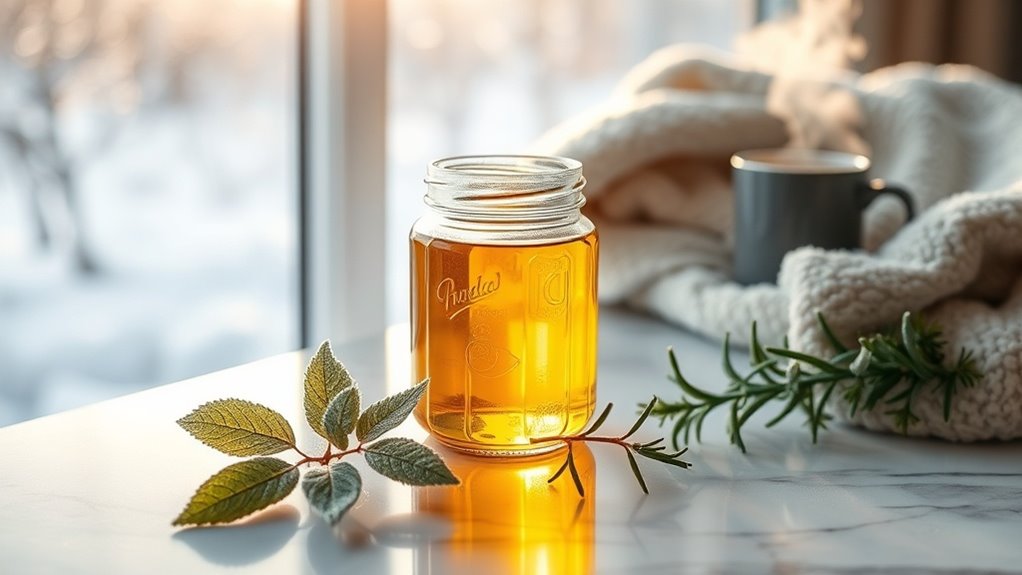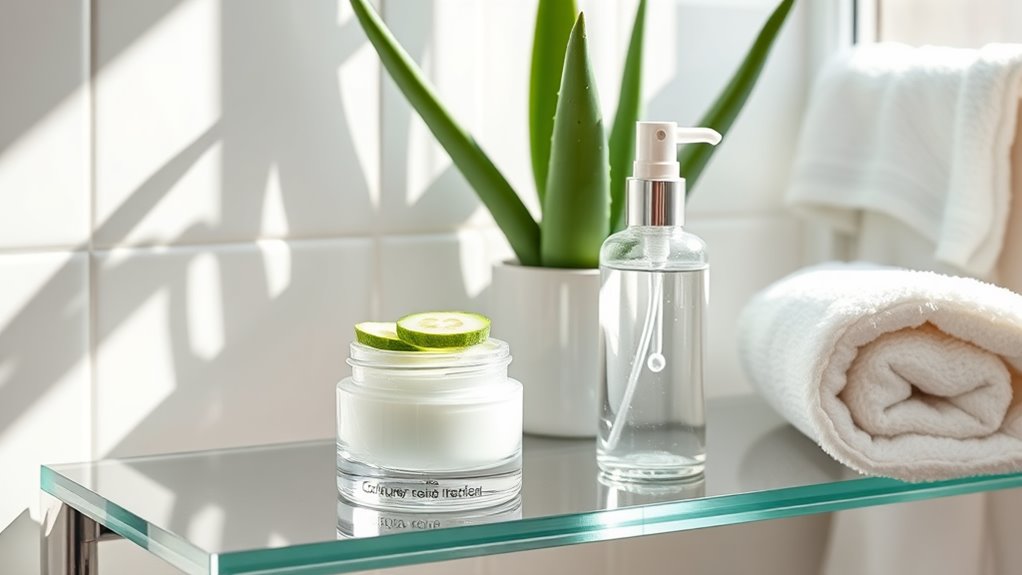Why You Should Change Your Skincare With the Weather
Changing your skincare routine with the seasons isn’t just a suggestion; it’s a necessity for maintaining optimal skin health. As temperatures fluctuate and humidity levels shift, your skin’s needs evolve. This adaptation can help prevent dryness, irritation, and other skin issues that arise from environmental changes. Understanding how to tailor your regimen can lead to a more balanced, radiant complexion year-round. Let’s explore the key factors influencing your skincare choices.
Understanding Seasonal Skin Changes
As the seasons shift, your skin undergoes significant transformations that can affect its health and appearance. The weather plays a crucial role in these changes, impacting humidity levels, temperature, and UV exposure.
In spring, increased moisture can rejuvenate your skin, while summer’s heat may lead to oiliness and sun damage.
As autumn arrives, dry air often strips moisture, necessitating richer skincare products to prevent flakiness and irritation.
Winter poses additional challenges, with cold winds and indoor heating causing dehydration and sensitivity.
Understanding these seasonal shifts helps you tailor your skincare regimen effectively, ensuring your skin retains its vitality throughout the year. Adapting your routine for seasonal skin issues can greatly improve your skin’s overall health and resilience.
Essential Ingredients for Different Weather Conditions
As the seasons change, so do your skin’s needs.
In summer, focus on hydration to combat heat and humidity, while in winter, prioritize barrier protection to retain moisture and shield against harsh conditions. Understanding these essential ingredients will help maintain your skin’s health year-round. Incorporating winter skincare swaps can further enhance your routine, ensuring your skin remains radiant and hydrated during colder months.
Summer Hydration Essentials
When it comes to summer skincare, many people underestimate the importance of hydration. During hot months, your skin loses moisture more rapidly, making it essential to replenish.
Look for lightweight, water-based moisturizers containing hyaluronic acid; this ingredient can hold up to 1,000 times its weight in water. Additionally, aloe vera and glycerin are excellent for providing moisture without clogging pores.
Incorporating antioxidants like vitamin C can enhance skin protection against UV damage while promoting hydration. Don’t forget to drink plenty of water to support inner hydration.
Lastly, consider using a refreshing facial mist during the day, which helps cool down the skin and maintain moisture levels. Keeping your skin properly hydrated ensures it looks radiant and healthy all summer long.
Winter Barrier Protection
Hot summer days can bring a host of skincare challenges, but winter introduces a new set of concerns, particularly regarding skin barrier protection. As temperatures drop, your skin’s natural barrier can become compromised, leading to dryness and irritation.
To combat these effects, focus on essential ingredients like occlusives, humectants, and emollients. Ingredients such as ceramides, hyaluronic acid, and squalane help reinforce the skin’s barrier, trapping moisture and preventing transepidermal water loss.
Additionally, antioxidants like vitamin E can protect against environmental stressors. Incorporate these into your routine with heavier creams and oils to provide that crucial layer of protection your skin craves in colder months.
Adjusting your regimen now will maintain your skin’s health and resilience all winter long.
Adjusting Your Cleansing Routine
As seasons change, your skin undergoes various shifts that can affect its cleansing needs. You’ll want to select products that align with these seasonal variations and adjust how often you cleanse to maintain optimal skin health. Understanding these factors ensures your routine supports your skin’s unique requirements throughout the year. Additionally, be mindful to avoid common cleansing mistakes, as they could inadvertently harm your skin.
Seasonal Skin Changes
While the changing seasons can bring joy, they also significantly impact your skin’s needs, particularly when it comes to cleansing.
During colder months, your skin tends to lose moisture, leading to dryness. This means a gentle, hydrating cleanser is essential to avoid stripping essential oils.
On the other hand, warmer weather often increases sweat and oil production, necessitating a more effective foaming or exfoliating cleanser to prevent clogged pores.
Additionally, humidity can encourage bacterial growth, making it crucial to adjust the frequency of your cleansing routine.
In essence, by observing these seasonal shifts and tailoring your cleansing approach, you’ll support your skin’s health and resilience throughout the year.
Understanding these dynamics can make a significant difference in your skincare efficacy.
Product Selection Tips
To effectively adjust your cleansing routine, consider your skin’s unique needs in relation to seasonal changes.
In warmer months, opt for lightweight, gel-based cleansers that effectively remove sweat, oil, and impurities without over-drying. Look for ingredients like salicylic acid or tea tree oil that help prevent breakouts during the hotter, more humid days.
Conversely, in cooler months, hydrate your skin with cream-based cleansers. These are typically rich in emollients that help maintain your skin’s natural moisture barrier.
Avoid harsh sulfates, as they can strip the skin of essential oils, leading to irritation.
Selecting the right product for the season helps preserve your skin’s health and enhances its resilience against environmental stressors. Always pay attention to your skin’s responses to these changes.
Adjusting Cleansing Frequency
Understanding how the weather impacts your skin also involves adjusting your cleansing frequency. In humid conditions, your skin tends to produce more oil, so you might need to cleanse twice daily to prevent clogged pores and breakouts.
Conversely, during colder months, the skin can become dry and sensitive. You may want to reduce your cleansing to once a day, using a gentle cleanser to maintain the skin’s natural moisture barrier.
Additionally, consider incorporating a hydrating toner after cleansing to replenish lost moisture. Pay attention to your skin’s response and adjust as necessary.
The Importance of Moisturizing Throughout the Year
Moisturizing your skin is crucial year-round, as environmental conditions fluctuate and can significantly affect skin health.
During winter, low humidity can lead to moisture loss, causing dryness and irritation. Conversely, summer heat and humidity might prompt overproduction of oil, making hydration essential to maintain balance.
Regularly moisturizing helps restore the skin’s barrier function, preventing transepidermal water loss and ensuring optimal hydration levels.
Different types of moisturizers—such as creams, lotions, or gels—should be selected based on your skin’s needs and the season. For instance, heavier creams work well in colder months, while lighter formulations suit warmer temperatures.
Consistent moisturizing not only enhances overall skin appearance but also supports long-term resilience against environmental stressors. Additionally, understanding transepidermal water loss can further improve your moisturizing routine and skin hydration.
Prioritizing hydration is key for healthy, glowing skin.
Sun Protection Strategies for Every Season
As the seasons change, so do the sun’s effects on your skin, making it essential to adapt your sun protection strategies accordingly.
In winter, UV rays can still penetrate cloud cover, so use a broad-spectrum SPF of at least 30 daily. Remember that never skipping sunscreen is crucial for your skin’s best defense against UV damage.
During spring, as the sun becomes more intense, opt for a lightweight, water-resistant sunscreen for outdoor activities.
In summer, reapply every two hours, especially after swimming or sweating.
Fall’s lower UV index doesn’t mean you can skip protections; switch to a moisturizing sunscreen to prepare your skin for colder months.
Seasonal Exfoliation: Timing and Techniques
With seasonal changes not only affecting sun exposure but also your skin’s needs, exfoliation plays a vital role in maintaining a healthy complexion year-round.
As temperatures shift, so should your exfoliation technique. In spring and summer, opt for chemical exfoliants with AHAs or BHAs to remove dead skin cells and promote cell turnover, enhancing radiance.
During fall and winter, consider gentler exfoliation methods, such as enzymatic treatments or mild scrubs, to prevent irritation caused by drier air.
Timing is key; exfoliate 1-3 times weekly, adjusting frequency based on your skin type and sensitivity. Over-exfoliating can lead to barrier damage, which may hinder your skin’s health.
Always follow up with moisturizer and sunscreen, especially after exfoliation, to protect your skin’s barrier and lock in hydration, ensuring your complexion remains vibrant despite seasonal changes.




